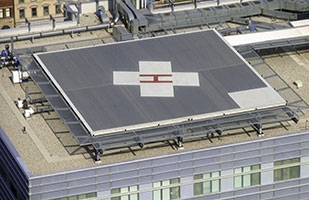Helipad Allowed on Roof of Cleveland Hospital

Today’s Supreme Court decision clears the way for a helipad at Cleveland’s Fairview Hospital.

Today’s Supreme Court decision clears the way for a helipad at Cleveland’s Fairview Hospital. (Getty Images)
The Ohio Supreme Court ruled today that Cleveland’s zoning laws permit Fairview Hospital to build a helipad on the roof of a new building.
A helipad qualifies as a permitted “accessory use” for a hospital in an area zoned as a local retail business district, the court unanimously held in an opinion written by Chief Justice Maureen O’Connor. The court’s decision allows the Cleveland Clinic Foundation to build a helipad on the roof of a garage at the hospital, which was the only one in Cleveland without a helipad.
In reversing the judgment of the Eighth District Court of Appeals, the court explained that the appellate court used an incorrect standard when reviewing the trial court’s decision.
Fairview Hospital, which is owned by the clinic’s foundation, sits on land zoned by the city of Cleveland as a local retail business district. The hospital houses an intensive care unit for high-risk infants and a trauma center for cardiac and stroke patients.
In October 2010, the clinic sought approval from the city to renovate a parking lot, construct a new two-story addition, and build a helipad on the addition’s roof. The city rejected the application. In denying the helipad, the city stated that it was not a permitted “accessory use” for property in a local retail business district. The Cleveland zoning code defines an “accessory use or building” as “a subordinate use or building customarily incident to and located on the same lot with the main use or building.”
The clinic and hospital appealed to the city’s board of zoning appeals (BZA). At a public hearing, opponents to the clinic’s plans expressed concerns about increased traffic, parking problems, noise, and safety. Those favoring the helipad noted that Fairview is the only hospital in Cleveland, and one of only two hospitals out of 14 in the metropolitan area, that does not have a helipad. The use of helicopters significantly cuts transport time to a hospital for critically ill patients, proponents testified.
While approving the parking lot renovation and the new building, the BZA denied a permit for a helipad finding it was not an accessory use.
The clinic and the hospital appealed to the Cuyahoga County Court of Common Pleas, which reversed the zoning board’s decision. The BZA filed an appeal with the Eighth District, which reversed and stated the helipad was not permitted. The clinic and hospital appealed to the Supreme Court.
Chief Justice O’Connor explained the standard courts are to use when reviewing appeals from local zoning boards. R.C. Chapter 2506 governs these appeals.
“R.C. Chapter 2506 confers on the common pleas courts the power to examine the whole record, make factual and legal determinations, and reverse the board’s decision if it is not supported by a preponderance of substantial, reliable, and probative evidence,” she wrote.
“By contrast, the standard of review for an appellate court reviewing a judgment of a common pleas court in this type of appeal is narrower and more deferential to the lower court’s decision. … The courts of appeals may review the judgments of the common pleas courts only on questions of law; they do not have the same power to weigh the evidence.”
The chief justice concluded that the Eighth District incorrectly reviewed the BZA’s ruling. Instead, the appeals court should have examined the common pleas court’s decision to determine whether that court misapplied or misinterpreted the law and whether the evidence supported that court’s decision.
In its review of the common pleas court’s ruling, the Supreme Court considered the Cleveland zoning ordinances as a whole.
Chief Justice O’Connor noted that the proposed helipad fits the meanings of “accessory use” in Cleveland’s zoning code because the helipad will be built on hospital land and is customarily incident to the property’s use as a hospital. Also, the ordinances include hospitals among the permitted buildings in a multi-family district and state that all uses allowed in a multi-family district are permitted in a local retail business district. The court found no provision that expressly prohibits helipads in either a local retail business district or a multi-family district.
“Given the record before us, we have little trouble concluding that the preponderance of substantial, reliable, and probative evidence supports the trial court’s conclusion that helipads are customarily incident to hospitals, at least in Cleveland,” Chief Justice O’Connor wrote. “The record establishes that every other hospital in Cleveland has a helipad and that nearly 88 percent of hospitals in the Cleveland metropolitan area have helipads. … In the absence of any evidence to the contrary, the only conclusion to be drawn from the record is that helipads are customarily incident to hospitals. Therefore, under the zoning provisions at issue here, the trial court properly found that the [h]ospital was entitled to construct the helipad ….”
Joining the chief justice’s opinion were Justices Paul E. Pfeifer, Terrence O’Donnell, Judith Ann Lanzinger, Sharon L. Kennedy, and Judith L. French and Judge Eve Belfance of the Ninth District Court of Appeals. Judge Belfance sat in place of Justice William M. O’Neill, who recused himself in the case.
2013-0654. Cleveland Clinic Found. v. Cleveland Bd. of Zoning Appeals, Slip Opinion No. 2014-Ohio-4809.
 View oral argument video of this case.
View oral argument video of this case.
Please note: Opinion summaries are prepared by the Office of Public Information for the general public and news media. Opinion summaries are not prepared for every opinion, but only for noteworthy cases. Opinion summaries are not to be considered as official headnotes or syllabi of court opinions. The full text of this and other court opinions are available online.
Acrobat Reader is a trademark of Adobe Systems Incorporated.


